
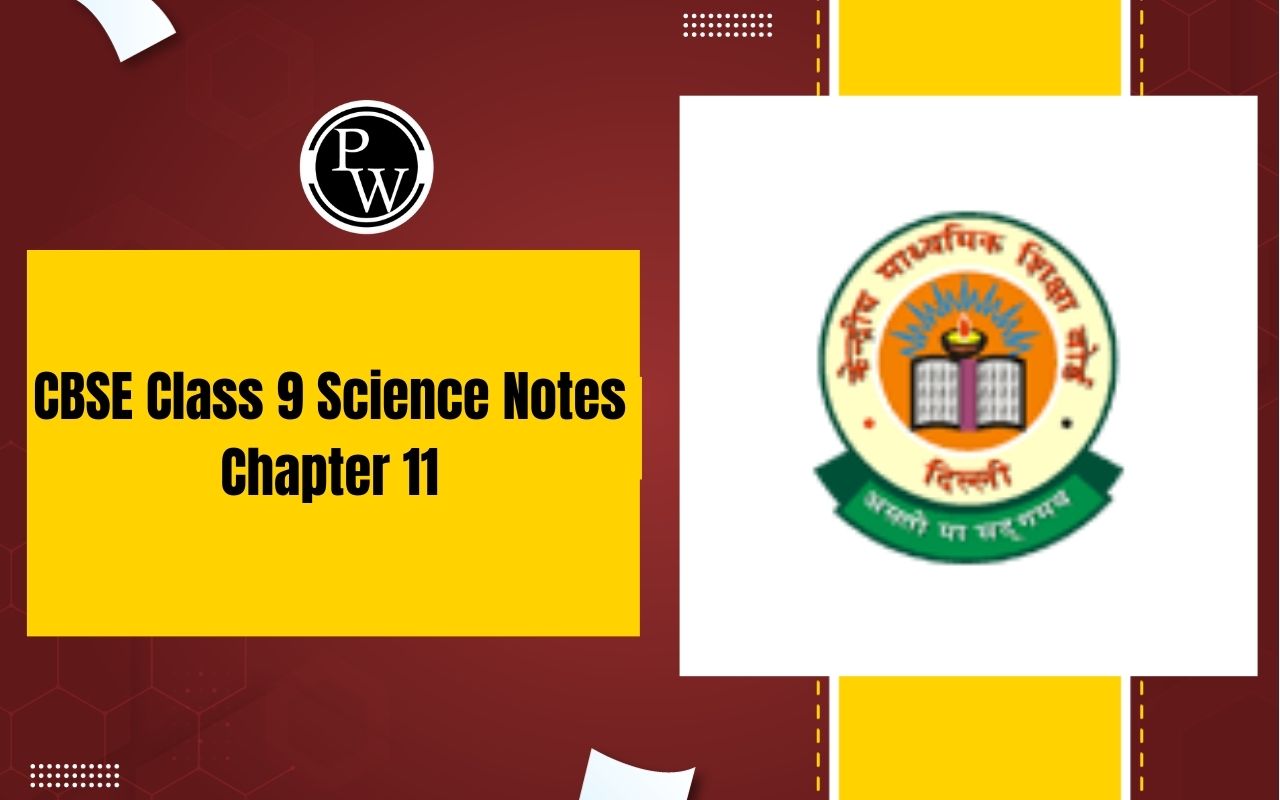
CBSE Class 9 Science Notes Chapter 11: With the comprehensive CBSE Class 9 Science Notes Chapter 11 PDF, students can now study science more easily in class 9. Each topic and subtopic are carefully explained to ensure that students grasp the material. The PDF versions of these explanations are now available on the website. These notes are your one-stop shop for convenient exam preparation.
Now consult them to gain a comprehensive understanding of the fundamental subjects of Work and Energy so that you may easily pass your tests. Students can access free notes and other study resources on our website.CBSE Class 9 Science Notes Chapter 11 Overview
The concepts of effort, energy, and power are thoroughly covered in Class 9 Chapter 11, "Work and Energy." In daily life, we refer to any productive physical or mental activity as work, but scientists have a distinct definition of the term. The amount of work a force does on an object is determined by multiplying its magnitude by the distance it moves in the force's direction. There is no direction and only magnitude to work. Similarly, we use the term "energy" a lot in our daily lives, yet science defines it differently. According to physics, energy is the quantifiable quality that is transferred to a physical system or body and is evident in the production of heat and light as well as in the performance of work.CBSE Class 9 Science Notes Chapter 11 PDF
For students in CBSE Class 9 Science Notes Chapter 11 offers a useful resource. It aids in the accessible introduction of science concepts. The notes are offered to clarify difficult concepts, facilitating the material's comprehension for students in Class 9. Through the use of our resources, students can gain a more thorough comprehension of NCERT principles. Students in class 9 can benefit greatly from these solutions, which will enable them to achieve academic success and cultivate a sincere appreciation for Work and Energy.CBSE Class 9 Science Notes Chapter 11 PDF
CBSE Class 9 Science Notes Chapter 11
People frequently discuss how much energy they use in their daily lives, and it's stated that energy never truly destroys It simply moves from one form to another, doing the task as it goes. When we observe low-level heat energy, for instance, certain energy forms are less helpful to us than others. Speaking about the extraction or use of energy resources, such as coal, oil, or wind, is preferable than discussing energy consumption per se. Kinetic energy is the quantifiable amount of energy that a bullet possesses when it moves quickly. The bullet gains energy because a charge of gunpowder, which lost some potential chemical energy during the process, worked on it. The labour that a microwave oven does, which in turn uses electrical energy from the electrical grid, gives hot coffee a quantifiable amount of thermal energy. Energy is always lost to other forms of energy, such as heat and sound, when work is done in practice to transfer energy from one form to another. For instance, the efficiency of an outdated light bulb to transfer electrical energy to visible light is just about 3%, whereas the efficiency of humans to convert chemical energy to light is approximately half of 50, or 25%.Work
The product of the force acting on the body and the displacement in the force's direction is the definition of work done on an object. W is equal to F.s. The Newton is the SI unit of force. The work done is zero when a force applied on a body result in no displacement. Say, pushing against a wall.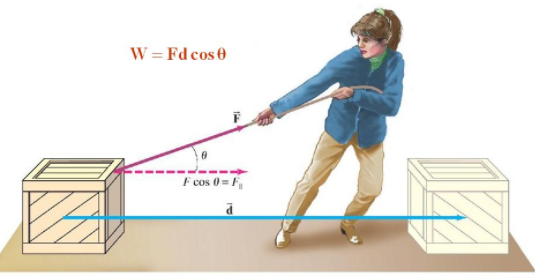 The force component along the direction of the body's displacement is given by the formula F cos θ. The angle formed by the force vector and displacement vector is denoted by Cos θ.
If we take a ball as an example, the work that the gravitational force does on it as it descends is equal to the weight of the ball, which is a force that is multiplied by the displacement or the distance to the ground. The work done may be found using the following formula when the force, F, is constant and the angle formed by the displacement and force is θ:
Work which transfers energy from one place to another or from one form to another.
The force component along the direction of the body's displacement is given by the formula F cos θ. The angle formed by the force vector and displacement vector is denoted by Cos θ.
If we take a ball as an example, the work that the gravitational force does on it as it descends is equal to the weight of the ball, which is a force that is multiplied by the displacement or the distance to the ground. The work done may be found using the following formula when the force, F, is constant and the angle formed by the displacement and force is θ:
Work which transfers energy from one place to another or from one form to another.
Why sometimes not much work is done despite working hard?
Energy is used in reading, writing, drawing, thinking, and analyzing. However, in the foregoing circumstances, no work is done scientifically. Example: A man is pushing a rock (a wall) until he is utterly tired, but there is no progress made because the wall is immobile. A man carrying a big bag and standing motionless may get fatigued soon, but since he is immobile, he cannot perform any labor.Work is said to be done when
(i) A moving object comes to rest.
(ii) an object at rest starts moving.
(iii) velocity of an object changes.
(iv) the shape of an object changes.
Energy
Energy is defined as the ability to do work. Its unit is the same as that of work. Energy is a scalar quantity. By now, we should all be aware that energy is essential to life itself. Energy seems to be needed at an accelerating rate. But the real query is: Where does energy originate? The sun, after all, is the main natural energy source for all living things. The sun is the main source of several energy sources. In addition, the earth's interior, tides, and atoms' nuclei can all provide us with energy.
Forms of Energy
Our world offers a myriad of forms of energy. These include- potential energy + kinetic energy (mechanical energy), light energy, chemical energy, electrical energy, and heat energy. Energy has different forms: Light, heat, chemical, electrical or mechanical. Mechanical energy is the sum of (i) Kinetic energy (K.E) (ii) Potential energy (P.E)Kinetic Energy
Objects in motion possess energy and can-do work. This energy is called Kinetic Energy.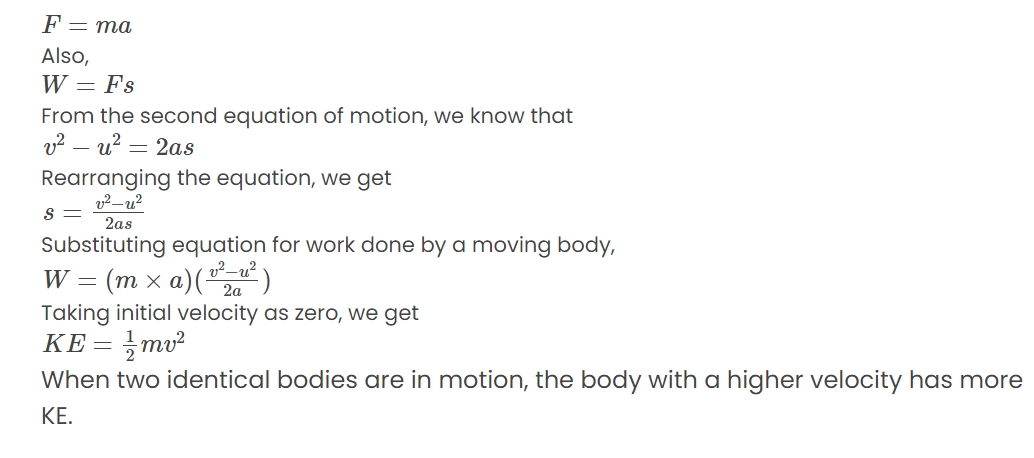

Examples of kinetic energy
- A moving cricket ball
- Running water
- A moving bullet
- Flowing wind
- A moving car
- A running athlete
- A rolling stone
Work-Energy Theorem
The work-energy theorem states that the net work done by a moving body can be calculated by finding the change in KE.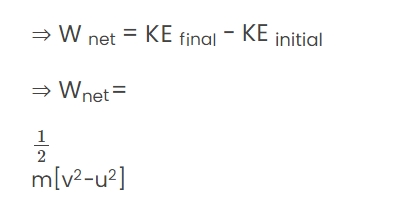
Factors Affecting Kinetic Energy
- Mass
- Velocity
- Momentum
Potential Energy
When work is done on an object, energy can be stored in it. As an illustration, extend a rubber thread. Potential energy is the energy that a body possesses as a result of its configuration or change in position.The potential energy of an object at a height
When an object is raised to a certain height, work is done against gravity to change its position. This energy is stored as Potential Energy.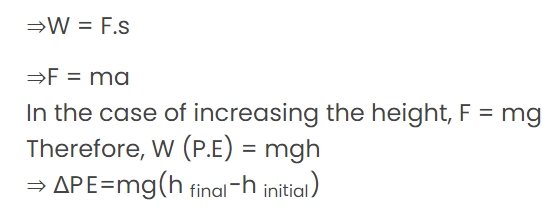
Law of Conservation of Energy
Energy can be transformed from one form to another, but it cannot be created or destroyed, according to the law of conservation of energy. Both before and after the transition, the total energy is the same.
Power
The rate of doing work or the rate of transfer of energy is called power. It is denoted by P.
Commercial Unit of Power
Since the joule is a very small unit, it cannot be used to accurately define large and specific amounts of energy. For this reason, the kilowatt hour (kW h), a larger unit, is utilized. 1 kW h is the amount of energy that can be obtained at a rate of 1 kW in roughly one hour. The commercial unit of power is kWh, i.e. energy used in 1 hour at 1000 Joules/second.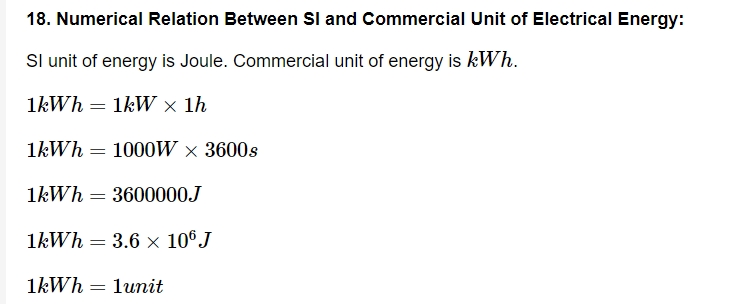
Holding an Object
A common cause of confusion for people is the idea of work, which arises when they consider holding a heavy object against gravity while it remains stationary above their heads. We are not moving the weight over any distance, hence the weight is not being worked on. This might also be accomplished by setting the weight on a table; in this case, it is evident that the table is not maintaining the weight's position. However, we know from past experience that we become fatigued when performing the same task. What's happening over here, then? It turns out that our bodies are actually working on our muscles in order to keep the appropriate tension that keeps the weight up. In order to accomplish this, the body sends a series of nerve signals to each muscle. The muscle contracts and releases briefly in response to each stimulus. These things happen so quickly that the first time we see them, we might only notice a small twist. Nevertheless Eventually, the muscle's supply of chemical energy runs out and is unable to sustain us. After that, we start to tremble and take a short break.Measurement of Energy and Work
The joule, represented by the sign J, is the common unit of measurement for work and energy in physics. 1 joule In the language of mechanics, this is the energy that is transferred when an item moves one metre when one Newton of force is applied to it. You may be familiar with calories, which represent yet another form of energy. Calories are frequently used on the back of food packaging to indicate how much energy it contains. For instance, a normal chocolate bar weighing sixty grammes has roughly two hundred and eighty calories. A calorie is defined as the amount of energy needed to raise one kilogramme of water one degree Celsius. Now, let me ask you this: why are we using kilogrammes instead of grammes in this instance? The answer to this is that one chocolate bar has 1.17 million joules, or 1.17 MJ, of stored energy. This translates to 4184 joules per calorie. If we look, that's a lot of joules.Benefits of CBSE Class 9 Science Notes Chapter 11
Students can access free notes and other study resources on the website. Math students looking for better answers can download the class 9 notes, which will help them review the entire syllabus and get higher grades in their exams.- thorough explanations for every task and question, encouraging a better comprehension of the material.
- Presentation that is well-organized and easy to understand.
- Precise responses that correspond with the syllabus enhance student's self-assurance in their comprehension.
- visual tools to help explain difficult ideas, such as pictures and diagrams.
- Extra pointers and advice to improve student performance.
- Synopses of chapters for rapid editing.
- Resources that can be downloaded and used online for flexible study and revision.
CBSE Class 9 Science Notes Chapter 11 FAQs
What are the main points of work and energy?
Work, Energy and Power are fundamental concepts of Physics. Work is said to be done when a force (push or pull) applied to an object causes a displacement of the object. We define the capacity to do the work as energy. Power is the work done per unit of time.
How to score good marks in science class 9 cbse?
To score good marks in Class 9 CBSE, focus on understanding the concepts, practice regularly, use NCERT textbooks, and solve previous year question papers.
What are the two main types of energy?
Potential energy and Kinetic energy.
Talk to a counsellorHave doubts? Our support team will be happy to assist you!

Check out these Related Articles
Free Learning Resources
PW Books
Notes (Class 10-12)
PW Study Materials
Notes (Class 6-9)
Ncert Solutions
Govt Exams
Class 6th to 12th Online Courses
Govt Job Exams Courses
UPSC Coaching
Defence Exam Coaching
Gate Exam Coaching
Other Exams
Know about Physics Wallah
Physics Wallah is an Indian edtech platform that provides accessible & comprehensive learning experiences to students from Class 6th to postgraduate level. We also provide extensive NCERT solutions, sample paper, NEET, JEE Mains, BITSAT previous year papers & more such resources to students. Physics Wallah also caters to over 3.5 million registered students and over 78 lakh+ Youtube subscribers with 4.8 rating on its app.
We Stand Out because
We provide students with intensive courses with India’s qualified & experienced faculties & mentors. PW strives to make the learning experience comprehensive and accessible for students of all sections of society. We believe in empowering every single student who couldn't dream of a good career in engineering and medical field earlier.
Our Key Focus Areas
Physics Wallah's main focus is to make the learning experience as economical as possible for all students. With our affordable courses like Lakshya, Udaan and Arjuna and many others, we have been able to provide a platform for lakhs of aspirants. From providing Chemistry, Maths, Physics formula to giving e-books of eminent authors like RD Sharma, RS Aggarwal and Lakhmir Singh, PW focuses on every single student's need for preparation.
What Makes Us Different
Physics Wallah strives to develop a comprehensive pedagogical structure for students, where they get a state-of-the-art learning experience with study material and resources. Apart from catering students preparing for JEE Mains and NEET, PW also provides study material for each state board like Uttar Pradesh, Bihar, and others
Copyright © 2025 Physicswallah Limited All rights reserved.
Get App











